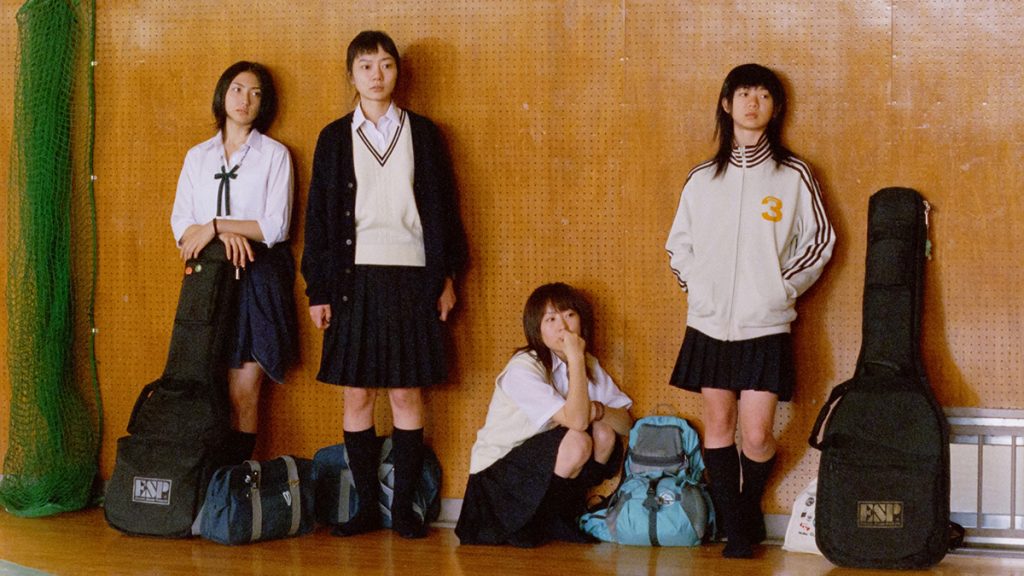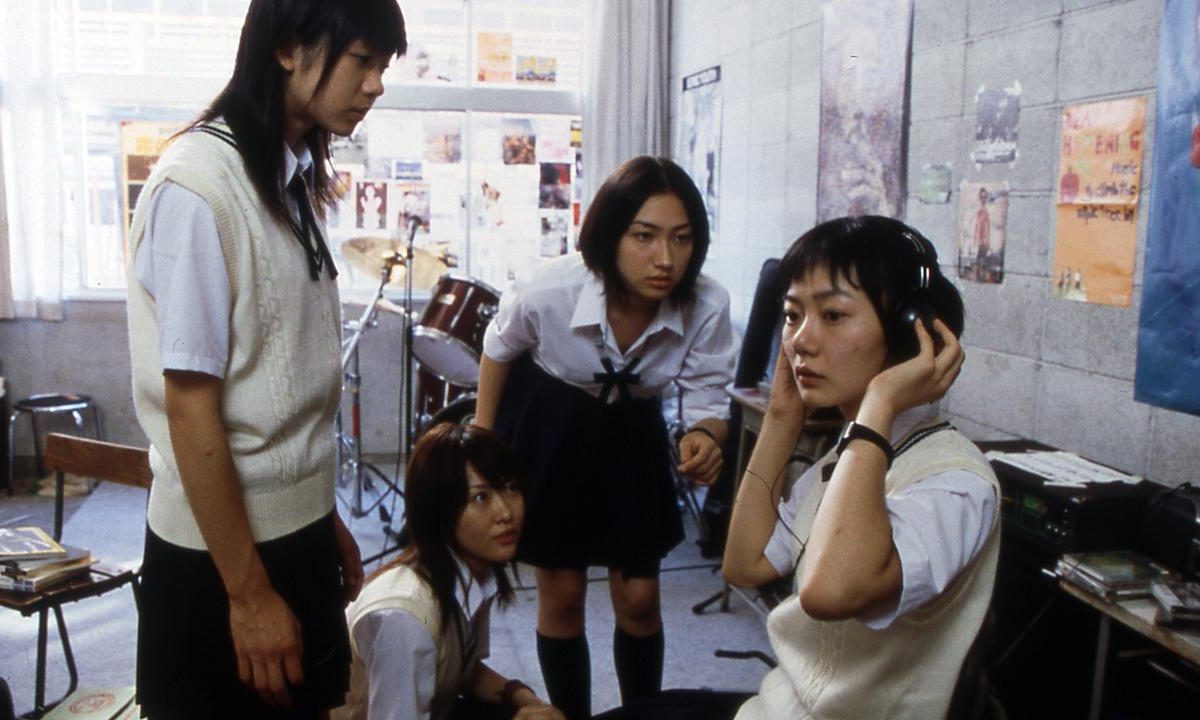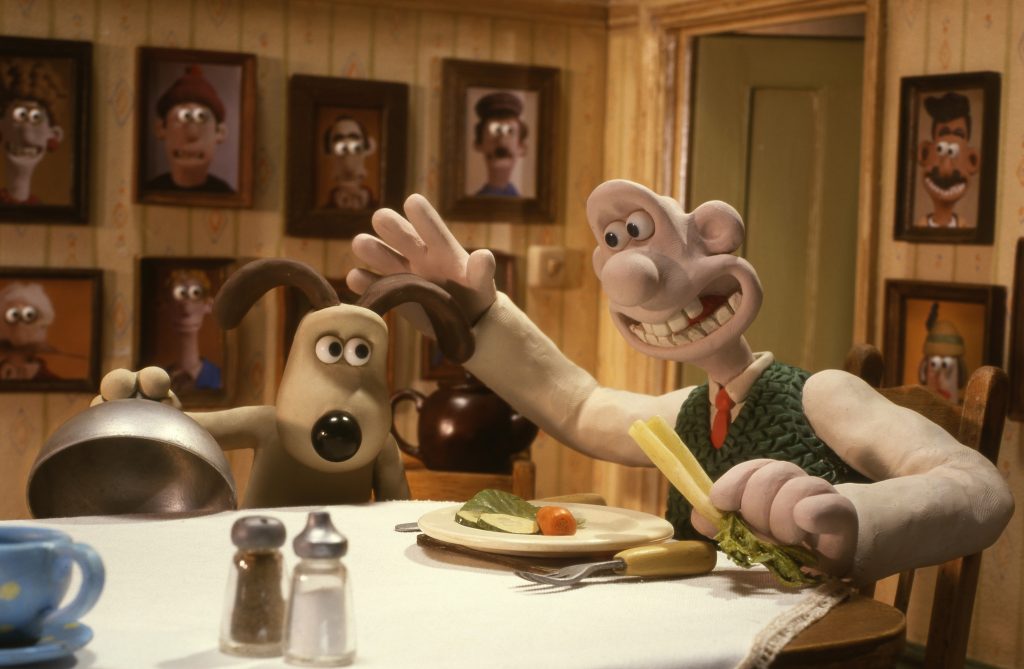Set the wayback machine to the mid-1980s. As neighborhood movie houses gave way to mall multiplexes, basic cable channels allowed movies that flopped at the box office to find a wider audience among their subscribers. Programming blocks like Night Flight, which aired overnight on the USA Network, created a new cult canon by broadcasting barely released films—Ladies and Gentlemen, The Fabulous Stains; Breaking Glass; Times Square— that blended the experimental film techniques and irreverent attitude of midnight movies with a music-forward style that was inspired by and responded to the growing influence of MTV.
Linda Linda Linda might make older audiences nostalgic for the glory days of basic cable, when a film like this would have found a place in the mono-counter culture. Like the Night Flight mainstays that preceded it, the 2005 feature follows an all-female punk band as they come of age and come into their own musically. Like its predecessors, it all but disappeared from American screening availability after a short arthouse run, in part due to its release in the years between the anything-goes era of basic cable and the similarly eclectic programming on free streaming services like Tubi. GKids has restored the film for a 20th anniversary rerelease, where it could finally find an American audience looking for a 21st-century cult hit.
It’s the late spring of 2004, and Kyoko, Kei, and Nozomi are getting ready to graduate from high school. One of their final duties is to perform at the High Holly Festival, but their lead singer quits and their guitarist breaks her hand. Undaunted, the remaining members decide to stay in the show, with keyboardist Kyoko teaching herself guitar. They choose to cover three songs by the Japanese punk band the Blue Hearts and find a lead singer by asking the first girl who walks past their rehearsal space. That girl is Korean exchange student Son, who’s lived in Japan for most of the school year but hasn’t quite mastered the language. Over the next three days, the newly formed quartet learn three songs while working the festival and preparing for their last days of school.
Linda Linda Linda sets itself apart from the movies that premiered before it by focusing on the process of becoming a band. We see the members of Paranmaum, or ”Blue Hearts” in Korean, learning their instruments and stumbling through cringe-inducing rehearsals. In some scenes, the band deals with issues that other young musicians can relate to, like scheduling rehearsal times with other bands that need the equipment room or Kyoko’s embarrassment when her ex-boyfriend lingers too long at their rehearsal space. Other scenes depict the problems that only the members of Paranmaum would experience, as in a slyly humorous scene when Son uses her shaky Japanese to get a discounted karaoke room so she can memorize the three Blue Hearts songs.

The protagonists of Linda Linda Linda feel more like the average teenager, American or otherwise, than the point-of-view characters in The Fabulous Stains or Times Square. Director Nobuhimo Yamashita focuses on the kinds of day-to-day setbacks and conflicts such teens would experience at an actual high school, like fights with friends and crushes on classmates. Their dowdy schoolgirl uniforms aren’t as sexy as Corinne Burns’s onstage negligees, and while the Blue Hearts were seen as controversial in Japan, the film doesn’t engage with the band’s history of spitting and swearing on TV; it’s easy to hear what inspired a wholesome teen punk band like the Linda Lindas in Paranmaum’s music.
Paranmaum’s shared rehearsal space may be decorated with an array of band posters and pin-ups, from Beat Happening to Marilyn Manson, but the focus remains on getting through their first show; the only sign of an ambition beyond the High Holly Festival is Kyoko’s whimsical, surreal dream of playing Budokan for the Ramones. Cinematographer Yoshihiro Ikeuchi’s frequent use of wide shots underscores the band’s low stakes, particularly in the final scenes when the band takes the stage. As a shot zooms out of the audience at their show, we see a group of excited students in a half-empty gym.
If Linda Linda Linda had been released 20 years earlier, would it have found an audience on pay cable? Hard to say. Paranmaum’s girl-next-door hijinx land closer to Mickey Rooney and Judy Garland than to the music industry gimmicks and casual drug use of Ladies and Gentlemen, The Fabulous Stains or the mental illness and parental neglect depicted in Times Square. At the same time, Paranmaum rock as hard as the Stains or the Sleez Sisters, and their understated exuberance makes it hard not to root for them. While Linda Linda Linda has been unavailable in America for almost 20 years, this would be a great start for young audiences with an interest in cult movies.
The 20th anniversary 4K restoration of “Linda Linda Linda” is currently playing around the country (including at NYC’s IFC Center).



